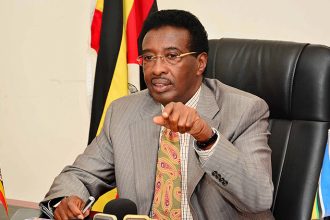Last weekend opposition outfit- Alliance for National Transformation ( ANT) announced a coalition arrangement with its newly formed counterpart- Peoples Front for Freedom( PFF).
The former is under the tutelage of former UPDF Chief of Defense Forces, Gregory Muntu with the later led by incarcerated four time presidential losing candidate, Col(rtd) Warren Kizza Besigye Kifefe.
The new arrangement has given birth to the debate over the possibility of a wider opposition unified front aiming to kick General Yoweri Kaguta Museveni’s National Resistance Movement ( NRM) out of power.
The move has since drawn mixed reactions, with some opposition enthusiasts speculating a possible transfer of power solely or largely driven by the actions of the two ex NRA combatants.
Unfortunately, there is some bad news everyone sharing the dream above needs to reacquaint themselves with. Political Coalitions are an old trend not only in Uganda but neighboring Africa and across the World. In Kenya forexample, the National Rainbow Alliance Coalition ( NARC) successfully marshaled KANU out of power after nearly four decades in 2002.
Since then, there have been one alliance after another at every general election. The same happened in Tanzania in 2015 with the opposition coalition forces upsetting the dominant CCM with a 40% result.
Unfortunately , such alliances have produced little to no results at all, setting pace for an almost obvious failure this time round too.
Ugandan Political Coalitions since Independence
The major political coalition in Uganda on the eve of independence in 1962 was arranged between two parties, the Uganda People’s Congress (UPC) and the Kabaka Yekka (“Only the King”, or KY) party. This political coalition is known in Ugandan historiography as the “unholy alliance”, because it was between two strange bed fellows.
The UPC leadership and base were ideologically unitary and republican in nature, having their roots in the struggles for social economic justice during the colonial period, when the economic division of labour was heavily racialized. Europeans dominated the most important productive sectors of the economy such as the import-export sector, finance, and banking, as well as the nascent industry.
Indians dominated the commercial sector, while Africans were largely in the least productive sector of crop farming. The party was thus strongly pro-social justice in orientation. KY, on the other hand, was monarchist, federalist, and favoured retaining the Buganda monarchy, which enjoyed a privileged status during the colonial era.
However, despite the ideological differences, the two parties formed an unprincipled coalition to defeat their common rival, the Democratic Party (DP). Their electoral alliance temporarily succeeded, and the two parties even went ahead to form a coalition government based on sharing cabinet posts. As widely predicted, it did not last long. There was no ideological proximity or convergence between the coalescing parties.
The UPC/KY alliance broke up in 1964 and culminated in a political crisis in 1966, when the leaders of the two parties clashed and King of Buganda Edward Mutesa II (the de facto head of KY, doubling as Uganda’s ceremonial head of state) was deposed and exiled by his coalition partner, UPC leader Milton Obote. The latter went on to abolish the monarchy in Uganda. The lesson here was that an alliance based on political convenience to take office and enjoy the spoils of power cannot succeed—at least not for long. To be successful, a coalition needs policy-based goals inspired and motivated by a vision of legal and constitutional reform.
Another major coalition formed in 1979 between exiled political groups in Moshi, Tanzania. Dubbed the Uganda National Liberation Front (UNLF), its goal was to overthrow dictator Idi Amin. Like the unholy alliance of 1962, the UNLF was also a coalition of convenience to remove a military regime. The parties coalescing in 1979 sought to overthrow Idi Amin and subsequently share political office. Cracks began to emerge in the UNLF shortly after overthrowing Amin, seizing power, and installing President Lule, who was in turn overthrown 68 days later by the same coalition parties.
His successor, President Godfrey Binaisa, was also deposed within eleven months of taking office. The UNLF was an unstable and uneasy coalition, as the leadership had little in common when it came to policy. The different political groups that formed the coalition had limited objectives—to depose Idi Amin and take power. They shared no broader ideological or policy goals, and were merely interested in taking office and the accompanying spoils once in power.
Yet another coalition emerged in 1982 between the Popular Resistance Army (PRA), led by Yoweri Museveni, and the Uganda Freedom Fighters (UFF), led by former President Yusuf Lule. This political coalition formed in the bushes of Luwero, Central Region of Uganda, where the two rebel factions were fighting a war against the Milton Obote government.
This was also a coalition of convenience between the conservative forces of the UFF and the then-radical and socialist-oriented forces of the PRA to form the National Resistance Movement (NRM). This was an uneasy alliance, maintained by the sheer fear of being defeated and killed in the war. Analysts argue that if former president Lule had not died of natural causes while still in exile in 1982 and been subsequently replaced by his deputy, Museveni, in all likelihood the two forces would have clashed. After all, Museveni had been an active participant in the camp that deposed Lule in 1979.
Lule and Museveni had nothing in common in terms of future plans, ideological orientation, or what society they wanted to build in Uganda. If the NRM had come to power in 1986 when President Lule was still alive, its fortunes would have been different and the coalition forces between Lule and Museveni would have inevitably followed the pattern of coalition politics in Uganda. This coalition has since disintegrated since the NRM came into power in 1986. The UFF forces lost their identity in due course. Some had hoped for a cultural-based federal system in Uganda, but they did not succeed and later abandoned the cause, now championed by other actors such as the Buganda Kingdom organization, which still pursues the cause of cultural federalism.
The National Resistance Movement (NRM) that took power in 1986 and remains in place did not allow electoral political competition in Uganda for ten years, from 1986 until 1996. It also did not allow political parties to organize and assemble for 20 years, until 2006. The NRM allowed general elections to take place in 1996, but under the movement system, according to which political parties were banned from sponsoring candidates.
Nevertheless, as soon as elections were permitted, yet another political coalition bringing together all de facto political parties and organizations formed: the Inter-Party Forces Coalition (IPFC). It was led by the veteran politician Paul Ssewogerere, who had already competed with Obote back in 1980. This was repeated in the 2011 elections, when the opposition parties formed the Inter-Parties Coalition (IPC) led by retired colonel Kiiza Besigye.
These were both uneasy coalitions, as some parties would not join and even those who did continued to grumble, among other grievances complaining that the major parties such as the FDC were stealing their supporters. After the elections, these coalitions would disintegrate and acrimony would ensue until another general election took place.
Before the 2015 elections, all opposition parties and forces attempted to form an electoral coalition known as The Democratic Alliance (TDA). Negotiations took place between the notable contenders for a joint candidacy of the opposition.
Former Vice-President Gilbert Bukenya and former Prime Minister Amama Mbabazi were among them. The two had served in the NRM under Museveni but fell out with him over the issue of presidential succession, among others. Many meetings and negotiations took place between the opposition parties and some non-state actors.
These involved the existing political parties, the most important (FDC) led by Besigye. The other force involved in these negotiations was the Go-Forward outfit led by Amama Mbabazi, who had split from the NRM. Another contender was presidential aspirant and later candidate Betty Kamya (presently serving as a minister in Museveni’s government) with her party Uganda Federal Alliance (UFA).
Protracted negotiations continued, but the parties failed to agree on a single candidate. The opposition parties and forces nominated Amama Mbabazi, but the FDC rejected his candidacy and the TDA alliance collapsed. The parties subsequently faced Museveni individually.
The writer is the Deputy RCC for Nakawa City Division




















